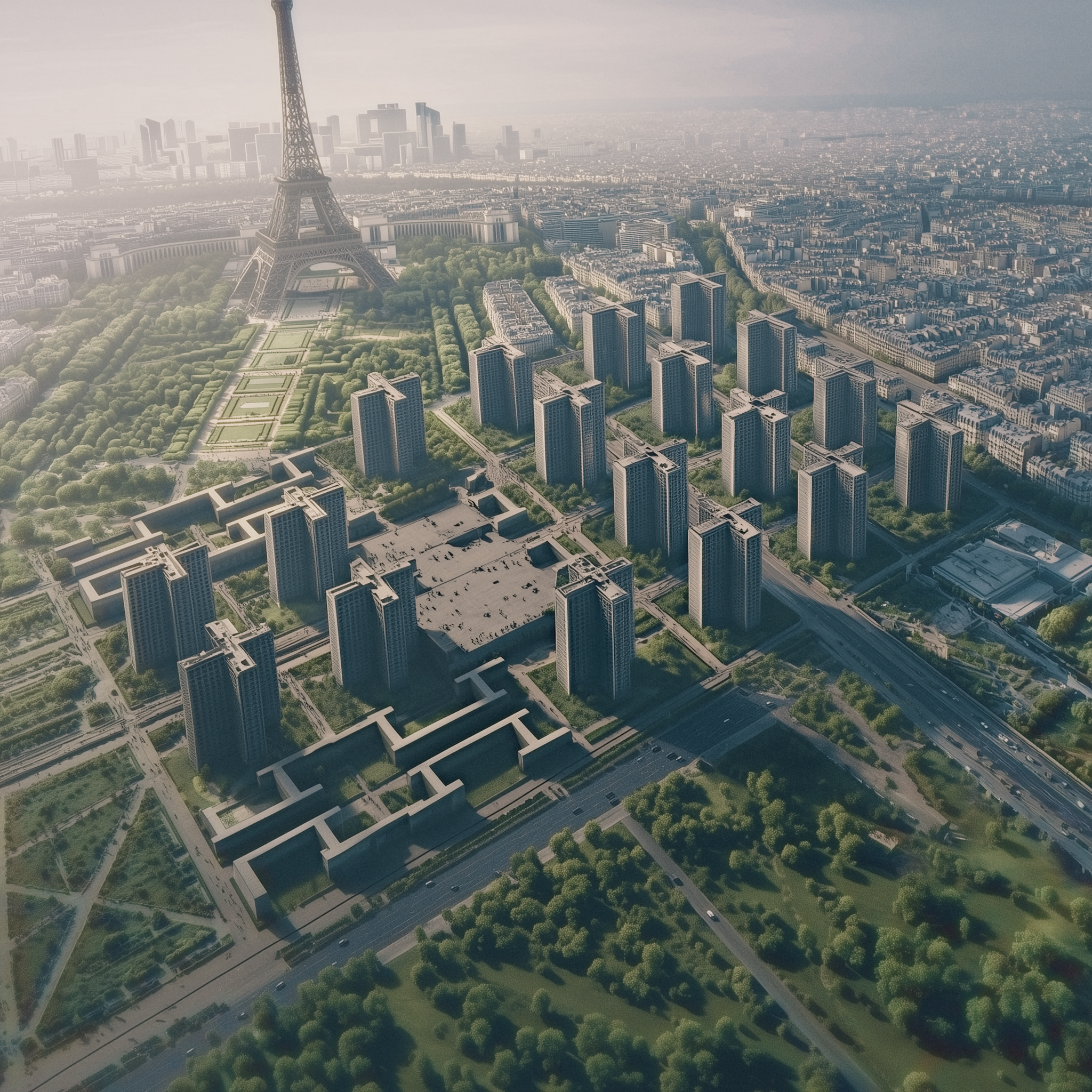What if Le Corbusier’s Plan Voisin Had Been Realized? An Photography Exploration through AI

The Plan Voisin: A Visionary Project for Paris
In 1925, Franco-Swiss architect and urban planner Le Corbusier, a pioneer of modernist architecture, proposed the Plan Voisin to transform the heart of Paris. This bold project sought to reshape the French capital in response to the growing challenges of urbanization. Le Corbusier envisioned a reimagined Paris where towering cruciform skyscrapers would replace historic neighborhoods around Les Halles and Le Marais, creating an airy, functional, and modern city.
The main ideas behind the Plan Voisin revolve around three fundamental concepts:
- Cruciform Residential Skyscrapers: Le Corbusier envisioned 60-story cross-shaped towers designed to maximize natural light and ventilation while offering unobstructed views.
- Green Spaces and Airy Boulevards: The plan included vast green spaces around the towers, where pedestrians could move freely, while dedicated roads below would accommodate vehicular traffic.
- Functionality and Urban Hygiene: Influenced by hygienist movements, Le Corbusier wanted a city free of narrow, unsanitary streets, promoting instead a strictly geometric and orderly layout.
Le Corbusier: A Visionary of Urban Modernism
Born Charles-Édouard Jeanneret-Gris in 1887, Le Corbusier is among the most influential architects of the 20th century. His modernist theories, grounded in functionality and minimalist aesthetics, transformed the way buildings and urban spaces were conceived. Obsessed with order and symmetry, he saw architecture as a tool for social progress. Although the Plan Voisin was never realized, it remains a reference point for understanding modernist ambitions and the debates surrounding urban evolution.
What Would Paris Look Like Today if the Plan Voisin Had Been Realized?

Thanks to generative AI technology and period public archives, we now have the means to imagine, in photorealistic detail, what Paris might have looked like if the Plan Voisin had been adopted. By combining Le Corbusier’s original plans and sketches with AI-powered image creation tools, this article offers a visual and architectural exploration of an alternate Paris where historic monuments give way to steel and glass skyscrapers surrounded by vast green spaces.
A Vision Reimagined through AI Technology

With today’s generative AI technologies, it’s now possible to photorealistically recreate a Paris transformed by Le Corbusier’s Plan Voisin. Using the period’s plans, sketches, and archives along with current photographs of the city, AI enables us to visualize this radical redesign and immerse ourselves in a utopian Paris where modernism and functionality take precedence over historical heritage.

These precisely generated, fictional images reveal a reimagined Parisian center: towering cruciform skyscrapers dominate the landscape, surrounded by green spaces and wide avenues for pedestrians and vehicles. Natural light floods every space, and the architecture is designed to maximize efficiency and residents’ well-being, with each structure following a geometric order—hallmarks of Le Corbusier’s style.
Paris: Between Heritage and Modernity
In this alternate universe, historical Paris has given way to a futuristic metropolis, both minimalist and monumental. Iconic buildings around Les Halles and Le Marais have been replaced by functional towers, and the charm of ancient streets has been redefined through open spaces and modern lines. Although this imagined Paris might seem cold to some, it embodies a vision of a world where architecture and urban planning prioritize practicality and efficiency.

These reconstructions invite us to reflect on what Paris might have become, and on the compromises such a choice would have entailed for cultural heritage preservation. This approach highlights how the balance between tradition and modernity remains a fundamental challenge for today’s architects.
A Utopian Paris: A Tool for Reflection for Architects
For contemporary architects, this imaginary reconstruction raises fascinating questions. How can we design modern spaces while preserving heritage? How can technology help us revisit and learn from past architectural visions? Generative AI paves the way for new forms of visual experimentation, offering a glimpse into urban utopias that never materialized.

This exploration also provides an opportunity to revisit Le Corbusier’s modernist principles, considering how they might be applied or adapted to today’s challenges: sustainability, controlled urbanization, and citizens’ well-being. By creating photorealistic images of this transformed Paris, AI doesn’t merely recreate a fictional world; it sparks reflection on the evolution of urban planning and architecture.
